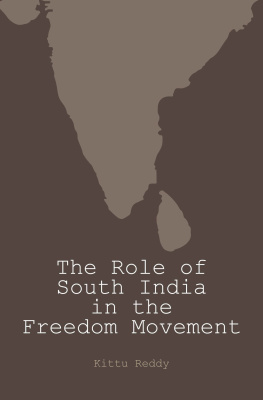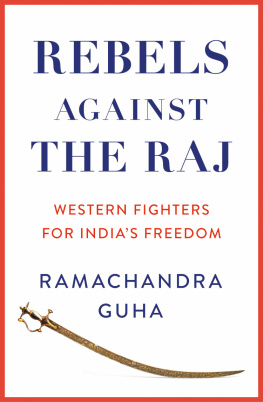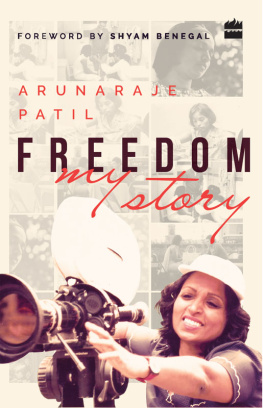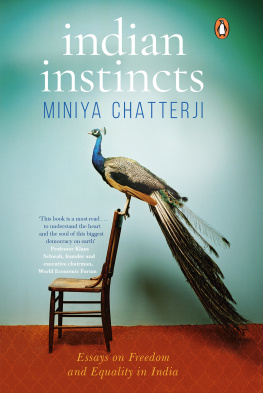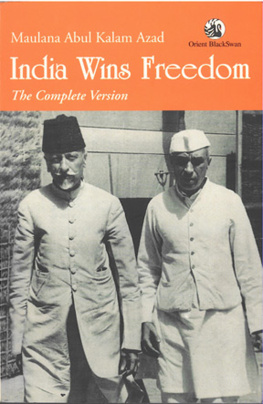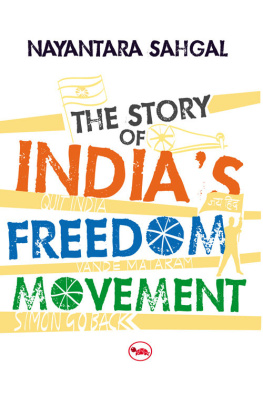The Role of South India in the Freedom Movement
By Kittu Reddy
First Edition November 24, 2014
ISBN: 978-93-82547-78-5
Published by
Savitri Foundation
10, Jorbagh,
New Delhi 110 003
Ph: 011-43001448
E-Mail: info@savitri.in
Website: http://www.savitri.in
Introduction
In September 2009, I received a letter from Prof Kireet Joshi requesting me to write a book on the role of South India in the Freedom Movement. The letter is reproduced below. This is the genesis of the book. Unfortunately Prof Kireet Joshi fell ill soon after the book was completed and I sent it to him. It could not therefore be published at that juncture. I have now decided to pulish the book on my own.
GUJARAT EDUCATION INNOVATIONS COMMISSION
KIREET JOSHI
Executive Chairperson
K-206, Sector 19
Gandhinagar
Tel. No. (079) 232 49744
Email:
29 September 2009
Shri Kittu Reddy
Sri Aurobindo Ashram Pondicherry
605 002
Dear Shri Kittu Reddy ji,
The Gujarat Government has set up recently the Gujarat Educational Innovations Commission, under which several Projects are being undertaken. One of these Projects will be related to the Fundamental Duties enshrined in the Constitution of India under Article 51A. Under this Article, it is laid down that it shall be the duty of every citizen of India to cherish and follow the noble ideals which inspired our national struggle for freedom.
Unfortunately, the role that has been played by the South in the Freedom Struggle and the ideals that have inspired leaders like Subramanian Bharati and others have never been highlighted. We would very much like to undertake a new Project of research, so that we may have an authentic story of the Freedom Struggle that developed in South India and the ideals that inspired the national struggle for freedom in South India. I am convinced that this Project of research which is being contemplated by the Commission will bring about a refreshing insight into the ideals that inspired our national struggle for freedom.
Considering your eminent background and scholarship, I should like to invite you to undertake the Project of the duration of four months, during which the account of the ideals which inspired the national struggle for freedom will be completed. The Project-holder of this Project will be required the complete the work within a period of four months.
I shall be grateful if you would like kindly agree to accept this Project and complete it by 31 st January 2010.
With warmest regards,
Yours sincerely,
(KIREET JOSHI)
Contents
Chapter 1
Introduction
This book presents the story of the freedom struggle that developed in South India and the ideals that inspired the national struggle for freedom in South India.
The presentation has two aspects; one, dealing with the events and incidents in which the freedom fighters were involved and two, the ideals and values that inspired the freedom fighters. The first represents the external side of the movement and the second the inner and deeper part.
It is evident that the inner part is more important as it portrays the lasting and abiding values and ideals that led and inspired this movement. We shall therefore first trace and identify the source of the inspiring ideals that were at the root of the Indian nation.
The Psychological Unity of India
In the history of India, we shall note that India became a nation state only in recent times; in a sense, only after the conquest by the British. However, the psychological sense of unity was there from the most ancient times. India had a fundamental cultural and spiritual unity rather than a political and economical unity.
For in India the spiritual and cultural unity was made complete at a very early time and it became the very basis of life of all this great surge of humanity between the Himalayas and the two seas. The peoples of ancient India were not so much distinct nations, sharply divided by a separate political and economic life; rather, they were sub-peoples of a great spiritual and cultural nation, itself firmly separated physically from other countries by the seas and the mountains, and from other nations by its strong sense of difference, its peculiar common religion and culture.
The whole basis of the Indian mind is its spiritual and inward turn; its propensity has always been to seek the things of the spirit and the inner being first and foremost and to look at all else as secondary, dependent, to be handled and determined in the light of the higher knowledge; the outer world was seen as an expression, a preliminary field or aid to the deeper spiritual aim. In other words, this approach led to a tendency to create whatever it had to first on the inner plane and afterwards in its other and outer aspects. The early mind of India understood the essential character of this problem. The Vedic Rishis and their successors made it their chief work to found a spiritual basis of Indian life and to effect spiritual and cultural unity of the many races and peoples of the peninsula.
What were the methods adopted by the ancients to bring about this spiritual and cultural unity?
Observing the religious and spiritual tendency of the Indian people, the ancient seers adopted a combination of different psychological and practical methods to bring about spiritual and cultural unity. As a first step, they created sacred religious places and distributed them all over the country; some of the places are in Haridwar, Prayag near Allahabad, Gaya, Nasik, Dwarka, Puri, Kumbakonam and Rameswaram.
One may also note the great influence of temples all over India. Not only were they religious places of worship, but structures of grandeur and beauty. There can be no doubt that the temples of India were a very powerful unifying factor. Starting from the South in Madura and Rameswaram right up to the north in Kashmir, in the East from Dwarka to the great temples in Assam, they have been a powerful religious, cultural and aesthetic unifying force.
Another method they adopted was the repetition of the sacred text, which in ancient times Indians used every time they bathed:
Gangecha Jamunechaiva Godavari
Sarasvatee Narmada Sindhu Kaveri jalesmin sannidhim kuru
And it means: May the Ganges, the Yamuna, the Godavari, the Sarasvatee, the Narmada, the Sindhu and the Kaveri enter into this water.
These are the great rivers of the Indian subcontinent and it is along the course of the great rivers that the sacred stream of Indian culture flowed all over the land. In addition, there were the legends of the gods and the two great epics the Ramayana and the Mahabharata which were read and moved people in every part of India. These legends were known by every Indian family and created a deep psychological bond among the people.
Finally, there was the universal reverence of the Vedas all over the country from the extreme North to the tip of South India.
Thus, from a very early period of Indian history, the Indian subcontinent had fully realised a very deep, though complex form of organic unity behind all the apparent diversities and multiplicities of the land and the people.
All these created a feeling that India was not just a geographical entity or a collection of people merely having the same religion and language. The Indian nation became a living being with a distinct personality, a dynamic psychological entity.
It is this feeling that has been expressed by poets and writers throughout the ages. In modern times, this was the whole meaning of Bandemataram and the songs of Subramaniam Bharati. The same feeling is beautifully expressed in the following words of the Mother and Sri Aurobindo.
India A Living Personality
Next page
